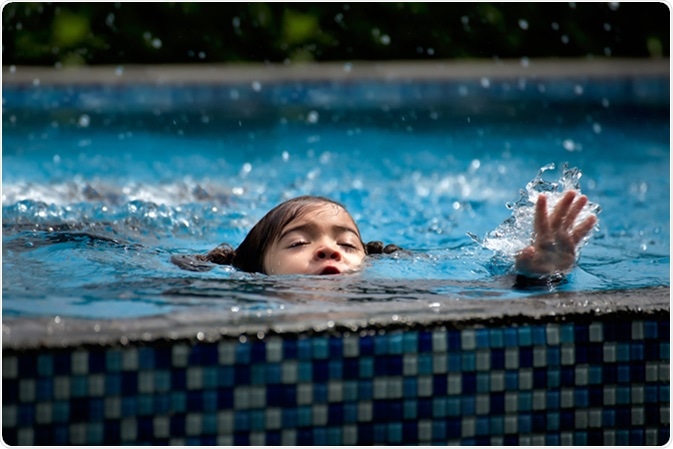Dry drowning (secondary drowning) is a type of drowning that can happen after being submerged underwater. It prevents the entry of oxygen into the lungs, leading to difficulty breathing and can cause pulmonary edema. Detecting dry drowning early is vital for immediate action to be implemented.

Image Credit: NITINAI THABTHONG / Shutterstock
What is Dry Drowning?
Drowning is the third leading cause of unintentional injury death worldwide. Every year, approximately 360,000 deaths associated with drowning occur across the globe. Children are at the highest risk of drowning.
Dry drowning is a form of drowning wherein the person is submerged in water, causing the closing of the vocal cords in an attempt to prevent water from entering the lungs. Laryngospasm occurs, making it difficult for water, as well as oxygen, to enter the lungs. As a result, difficulty breathing may be experienced due to the lack of oxygen in the body.
Although the protective mechanism aims to save the individual, it may cause further complications. When dry drowning occurs, pressure changes in the lungs when the airway closes and the individual is attempting to exhale. This can cause the air sacs in the lungs to be filled with fluid which can occur moments or hours after the incident. Furthermore, it can lead to the onset of pulmonary edema, which can make it hard to breathe.
What is dry drowning?
Signs and Symptoms of Dry Drowning
Dry drowning can have many signs and symptoms. The most obvious one is trouble breathing. This is characterized by rapid and shallow breaths, nasal flaring, intercostal retractions, pain in the chest, and persistent coughing. In some instances, children can vomit. Also, people who are dry drowning can be lethargic and weak, and have changes in behavior like being irritable, cranky, and combative. This is caused by lack of oxygen in the brain, depriving the nerve cells of sufficient oxygen to function.
What to Do
It’s crucial to spot dry drowning early for immediate medical action. Here’s what to do immediately after detecting the condition.
It is important to note that the amount of injury from drowning, including dry drowning, is based on how long the person is without oxygen.
Spot dry drowning, particularly in children
A child who exits the water may seem normal at first. But, if you suddenly notice the child struggling to breath, experiencing persistent coughing, and confusion, seek medical attention right away. Take note if the child becomes unconscious.
Observe for other signs of trouble breathing
Other signs of difficulty include nasal flaring, intercostal retractions, bluish lips, and pale skin. The child may also have palpitations and changes in mental status. Call 911 immediately or bring the child to the nearest hospital for the appropriate treatment.
Put the person or child in the recovery position if unconscious but breathing
Place the child in the recovery position if they are unconscious but breathing. Call medical attention or 911 for further assistance.
Open the airway
Open the patient’s airway by gently tilting their head back and lifting the chin. Make sure there is no obstruction in the airway.
If the individual becomes unconscious, begin CPR
- Tap the person and shout, “Are you okay?”
- Ask for help or call 911.
- Open their airway by laying them on their back. Tilt their head back while lifting the chin.
- Check for breathing.
- Provide two rescue breaths if the individual isn’t breathing. Breathe into the mouth twice while pinching the nose.
- If the patient is still unconscious, begin cardiopulmonary resuscitation (CPR).
- Give chest compressions by putting one hand in the centre of the chest. Put the other hand on top of the first one and lace the fingers together. Give 30 chest compressions at approximately two inches deep.
- After each set of chest compressions, give two rescue breaths.
- Continue until the child shows signs of life or if the emergency services have arrived.
Prevention is the Key
Dry drowning is a preventable injury. Prevention is the key to reducing the risk of this potentially fatal condition and this can be done by taking appropriate precautions around water. Children who are four years and older should have swimming lessons. They should always be supervised when swimming or when they’re near bodies of water.
Further Reading